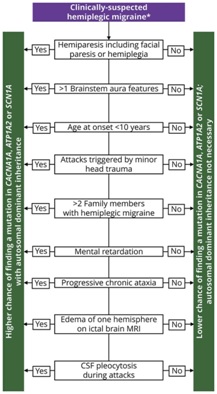Apart from ATP1A2 there are two other genes (CACNA1A and SCN1A) that can cause familial/ sporadic hemiplegic migraine, respectively FHM1/SHM1 and FHM3/SHM3. Diagnosis can be confirmed by genetic testing. Diagnostic testing should include sequence analysis and deletion/duplication analysis. However, not all individuals with hemiplegic migraine have a mutation in one of these genes. Depending on the clinical features, there is a higher or lower chance of finding a mutation (Figure 1). Generally speaking, patients with a mutation have a more severe phenotype. With FHM2/SHM2 there is reduced penetrance, meaning that not all individuals who carry a mutation in ATP1A2 will develop FHM2/SHM2.

Figure 1 Clinical characteristics of hemiplegic migraine and chances of finding a mutation in CACNA1A, ATP1A, or SCN1A with autosomal inheritance.
Management
In order to exclude other causes of disease it is advised to perform a cerebral MRI in every new hemiplegic migraine patient. Permanent MRI abnormalities are not common in FHM2/SHM2.
Due to the fact that FHM2/SHM2 is a rare disorder with a low attack frequency no large clinical treatment trails are available. Therefore, treatment of FHM2/SHM2 generally follows guidelines of common forms of migraine. Consequently treatment is only targeted on headache instead of the (often more debilitating) aura symptoms. Pharmacological agents that suggest some prophylactic effect in FHM2/SHM2 are: flunarizine, verapamil, sodium valproate and acetazolamide. Lamotrigine might have an effect on aura symptoms. One study on patients with an ATP1A2 mutations shows a positive effect of combinational therapy with sodium valproate and lamotrigine.
(Minor) Head trauma has been described as a trigger factor for severe attacks, thus patients might be advised not to practice contact sports.
